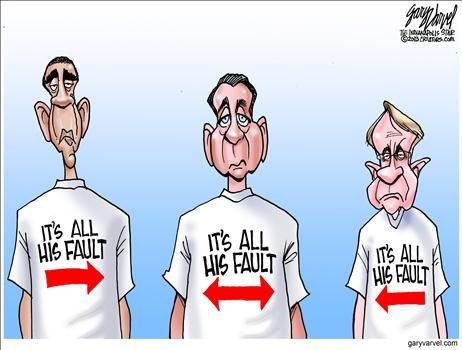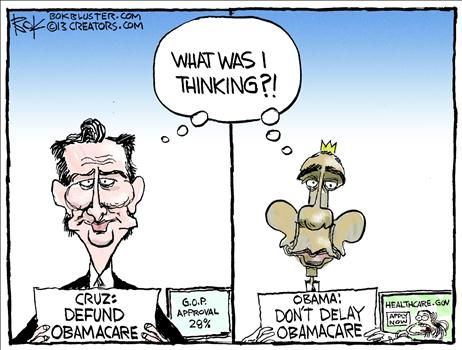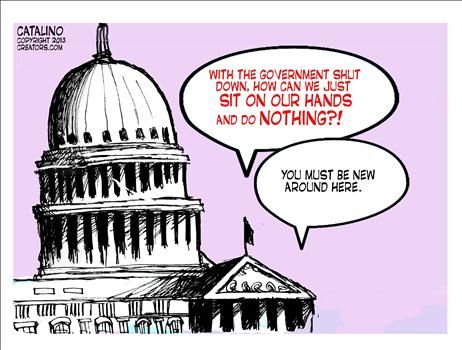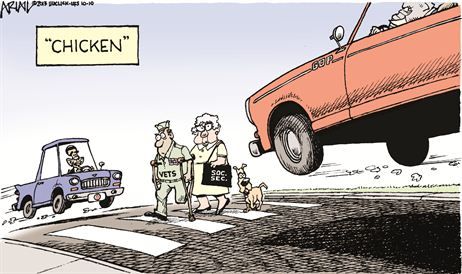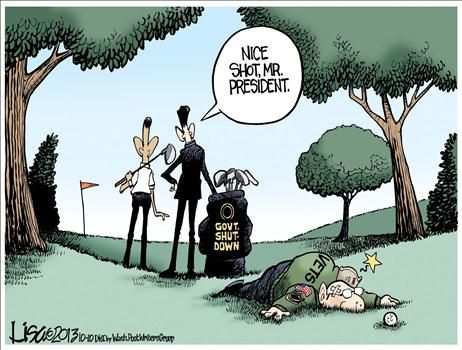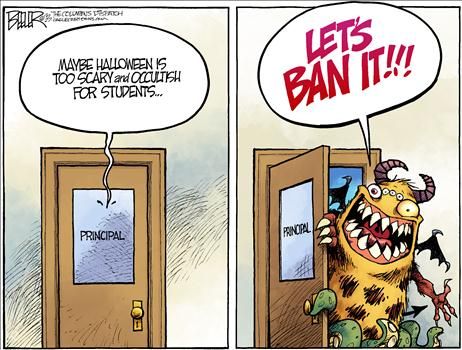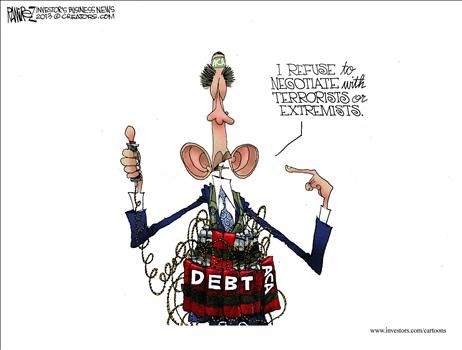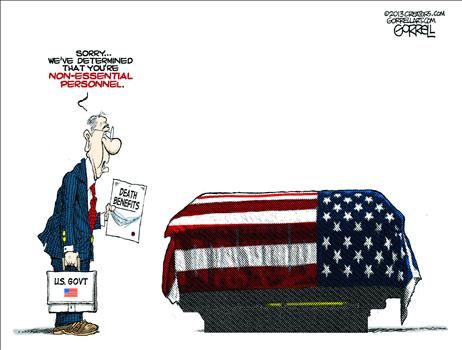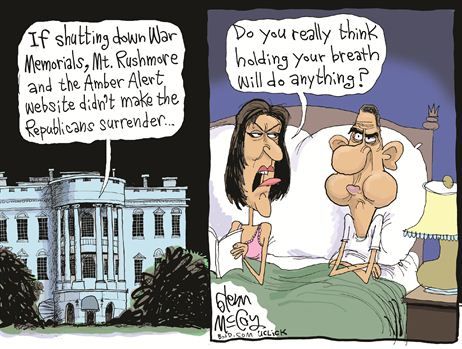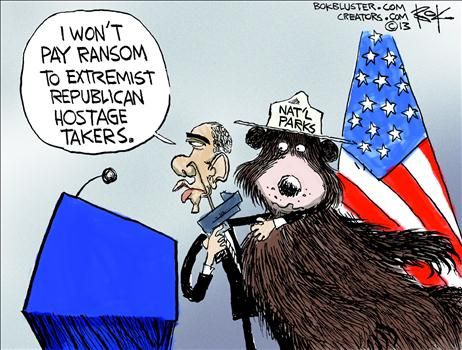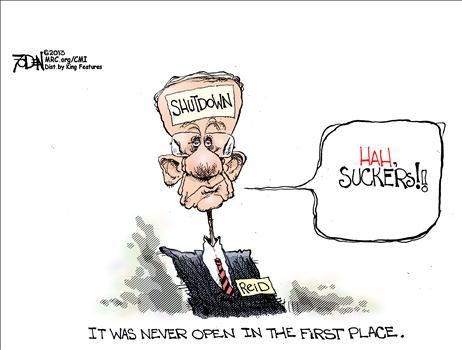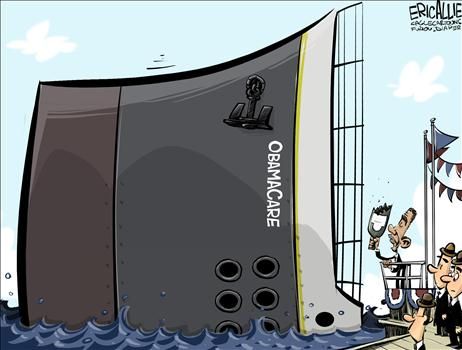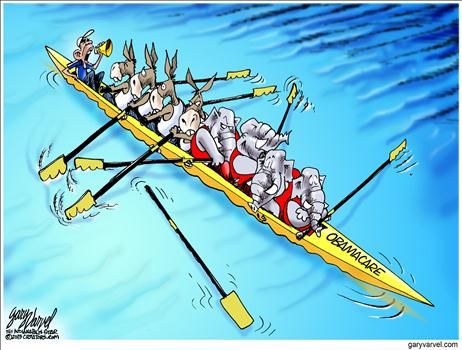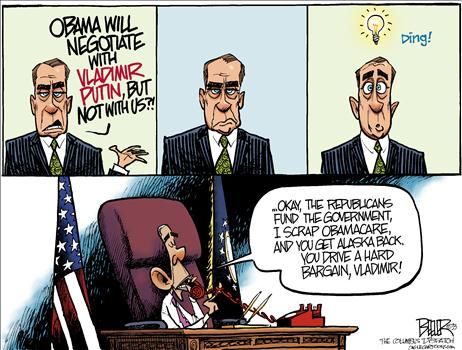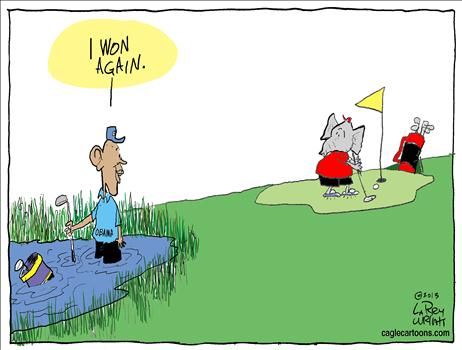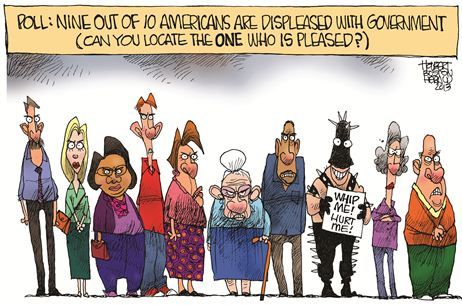
The government has King John’s idea of public lands.
By Mark Steyn
If
a government shuts down in the forest and nobody hears it, that’s the
sound of liberty dying. The so-called shutdown is, as noted last week,
mostly baloney: Eighty-three percent of the supposedly defunded
government is carrying on as usual, impervious to whatever restraints
the people’s representatives might wish to impose, and the 800,000
soi-disant “non-essential” workers have been assured that, as soon as
the government is once again lawfully funded, they will be paid in full
for all the days they’ve had at home.
But the one place where a full-scale shutdown is being enforced is in America’s alleged “National Park Service,” a term of art that covers everything from canyons and glaciers to war memorials and historic taverns. The NPS has spent the last two weeks behaving as the paramilitary wing of the DNC, expending more resources in trying to close down open-air, unfenced areas than it would normally do in keeping them open. It began with the war memorials on the National Mall — that’s to say, stone monuments on pieces of grass under blue sky. It’s the equivalent of my New Hampshire town government shutting down and deciding therefore to ring the Civil War statue on the village common with yellow police tape and barricades.
Still, the NPS could at least argue that these monuments were within their jurisdiction — although they shouldn’t be. Not content with that, the NPS shock troops then moved on to insisting that privately run sites such as the Claude Moore Colonial Farm and privately owned sites such as Mount Vernon were also required to shut. When the Pisgah Inn on the Blue Ridge Parkway declined to comply with the government’s order to close (an entirely illegal order, by the way), the “shut down” Park Service sent armed agents and vehicles to blockade the hotel’s driveway.
Even then, the problem with a lot of America’s scenic wonders is that, although they sit on National Park Service land, they’re visible from some distance. So, in South Dakota, having closed Mount Rushmore the NPS storm troopers additionally attempted to close the view of Mount Rushmore — that’s to say a stretch of the highway, where the shoulder widens and you can pull over and admire the stony visages of America’s presidents. Maybe it’s time to blow up Washington, Jefferson & Co. and replace them with a giant, granite sign rising into the heavens bearing the chiseled inscription “DON’T EVEN THINK OF PARKING DOWN THERE.”
But perhaps the most extraordinary story to emerge from the NPS is that of the tour group of foreign seniors whose bus was trapped in Yellowstone Park on the day the shutdown began. They were pulled over photographing a herd of bison when an armed ranger informed them, with the insouciant ad-hoc unilateral lawmaking to which the armed bureaucrat is distressingly prone, that taking photographs counts as illegal “recreation.” “Sir, you are recreating,” the ranger informed the tour guide.
And we can’t have that, can we? They were ordered back to the Old Faithful Inn, next to the geyser of the same name, but forbidden to leave said inn to look at said geyser.
But the one place where a full-scale shutdown is being enforced is in America’s alleged “National Park Service,” a term of art that covers everything from canyons and glaciers to war memorials and historic taverns. The NPS has spent the last two weeks behaving as the paramilitary wing of the DNC, expending more resources in trying to close down open-air, unfenced areas than it would normally do in keeping them open. It began with the war memorials on the National Mall — that’s to say, stone monuments on pieces of grass under blue sky. It’s the equivalent of my New Hampshire town government shutting down and deciding therefore to ring the Civil War statue on the village common with yellow police tape and barricades.
Still, the NPS could at least argue that these monuments were within their jurisdiction — although they shouldn’t be. Not content with that, the NPS shock troops then moved on to insisting that privately run sites such as the Claude Moore Colonial Farm and privately owned sites such as Mount Vernon were also required to shut. When the Pisgah Inn on the Blue Ridge Parkway declined to comply with the government’s order to close (an entirely illegal order, by the way), the “shut down” Park Service sent armed agents and vehicles to blockade the hotel’s driveway.
Even then, the problem with a lot of America’s scenic wonders is that, although they sit on National Park Service land, they’re visible from some distance. So, in South Dakota, having closed Mount Rushmore the NPS storm troopers additionally attempted to close the view of Mount Rushmore — that’s to say a stretch of the highway, where the shoulder widens and you can pull over and admire the stony visages of America’s presidents. Maybe it’s time to blow up Washington, Jefferson & Co. and replace them with a giant, granite sign rising into the heavens bearing the chiseled inscription “DON’T EVEN THINK OF PARKING DOWN THERE.”
But perhaps the most extraordinary story to emerge from the NPS is that of the tour group of foreign seniors whose bus was trapped in Yellowstone Park on the day the shutdown began. They were pulled over photographing a herd of bison when an armed ranger informed them, with the insouciant ad-hoc unilateral lawmaking to which the armed bureaucrat is distressingly prone, that taking photographs counts as illegal “recreation.” “Sir, you are recreating,” the ranger informed the tour guide.
And we can’t have that, can we? They were ordered back to the Old Faithful Inn, next to the geyser of the same name, but forbidden to leave said inn to look at said geyser.
Armed rangers were posted at the doors, and, just in case
one of the wily Japanese or Aussies managed to outwit his captors by
escaping through one of the inn’s air ducts and down to the geyser, a
fleet of NPS SUVs showed up every hour and a half throughout the day,
ten minutes before Old Faithful was due to blow, to surround the geyser
and additionally ensure that any of America’s foreign visitors trying to
photograph the impressive natural phenomenon from a second-floor hotel
window would still wind up with a picture full of government officials.
The following morning the bus made the two-and-a-half-hour journey to
the park boundary but was prevented from using any of the bathrooms en
route, including at a private dude ranch whose owner was threatened with
the loss of his license if he allowed any tourist to use the
facilities.
At the same time as the National Park Service was holding legal
foreign visitors under house arrest, it was also allowing illegal
immigrants to hold a rally on the supposedly closed National Mall. At
this bipartisan amnesty bash, the Democrat House minority leader Nancy
Pelosi said she wanted to “thank the president for enabling us to gather
here” and Republican congressman Mario Diaz-Balart also expressed his
gratitude to the administration for “allowing us to be here.”
Is
this for real? It’s not King Barack’s land; it’s supposed to be the
people’s land, and his most groveling and unworthy subjects shouldn’t
require a dispensation by His Benign Majesty to set foot on it. It is
disturbing how easily large numbers of Americans lapse into a
neo-monarchical prostration that few subjects of actual monarchies would
be comfortable with these days. But then in actual monarchies the king
takes a more generous view of “public lands.” Two years after Magna
Carta, in 1217, King Henry II signed the Charter of the Forest, which
despite various amendments and replacement statutes remained in force in
Britain for some three-quarters of a millennium, until the early
Seventies. If Magna Carta is a landmark in its concept of individual
rights, the Forest Charter played an equivalent role in advancing the
concept of the commons, the public space. Repealing various restrictions
by his predecessors, Henry II opened the royal forests to the freemen
of England, granted extensive grazing and hunting rights, and eliminated
the somewhat severe penalty of death for taking the king’s venison. The
NPS have not yet fried anyone for taking King Barack’s deer, but it is
somewhat sobering to reflect that an English peasant enjoyed more
freedom on the sovereign’s land in the 13th century than a freeborn
American does on “the people’s land” in the 21st century.
And we’re talking about a lot more acreage: Forty percent of the
state of California is supposedly federal land, and thus officially
closed to the people of the state. The geyser stasi of the National Park
Service have in effect repealed the Charter of the Forest. President
Obama and his enforcers have the same concept of the royal forest that
King John did. The government does not own this land; the Park Service
are merely the janitorial staff of “we the people” (to revive an
obsolescent concept). No harm will befall the rocks and rivers by
posting a sign at the entrance saying “No park ranger on duty during
government shutdown. Proceed beyond this point at your own risk.” And,
at the urban monuments, you don’t even need that: It is disturbing that
minor state officials even presume to have the right to prevent the
citizenry walking past the Vietnam Wall.
I wonder what those
Japanese and Australian tourists prevented from photographing bison or
admiring a geyser make of U.S. claims to be “the land of the free.” When
a government shutdown falls in the forest, Americans should listen very
carefully. The government is telling you something profound and
important about how it understands the power relationship between them
and you.
The National Park Service should be out of the business
of urban landmarks, and the vast majority of our “national” parks should
be returned to the states. After the usurpation of the people’s
sovereignty this month, the next president might usefully propose a new
Charter of the Forest.
